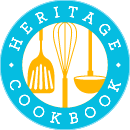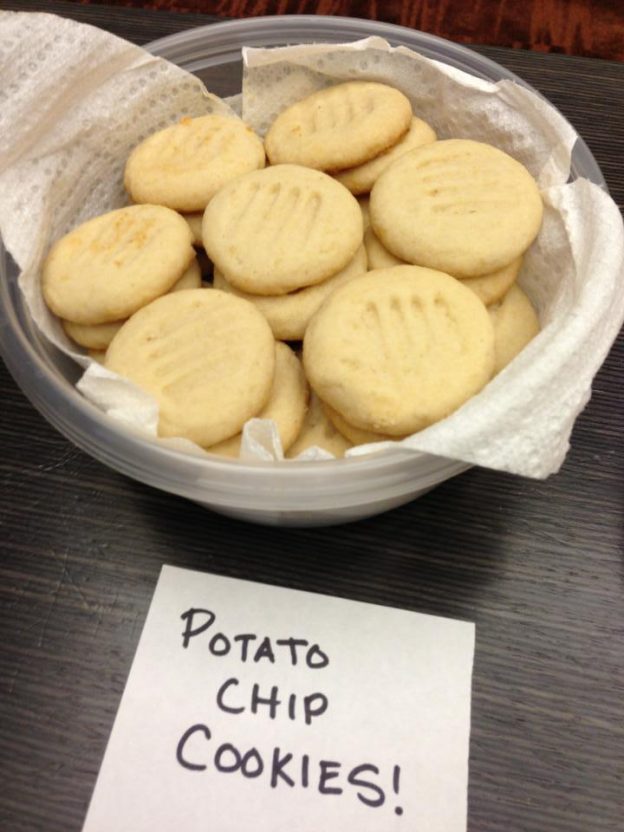Submitted by: Sara Levine Rosenblum
Recipe origin: USA
These are an all-time favorite Grandma Florence cookie, one that holiday guests and camp bunkmates requested time and time again. Years later, in my corporate life, these salty-sweet cookies won an office bake-off at Food Network! The crushed potato chips add a subtle salty crunch that is addictive.
Ingredients:
1 pound margarine or butter*
1 cup sugar
2 teaspoons vanilla
3 1/2 cups all-purpose flour
1 cup finely crushed potato chips
Confectioners’ sugar, for dusting
*Although margarine was a staple in my grandmother’s kitchen (sign of the times!), I (Sara) always use butter!
Cream margarine or butter and sugar. Add vanilla.
Mix in flour. Blend in crushed potato chips. Mix well with spoon (or mixer).
Take a piece of dough (size of a walnut), roll in your hands until smooth and flatten on lightly greased cookie sheet with your fingers (or you can drop the piece of dough and flatten with a fork). I prefer first method.
They spread so don’t make them too big. (Move each a little with a spatula after taking the cookie sheet from the oven so they don’t stick).
Bake at 350 degrees F for 10-12 minutes. Sprinkle with confectioners’ sugar when cooled.
Ready to turn your recipes into something memorable? Click here to get started!
January 12, 2025 | Posted in:

Slovakian Roshky (“Rushki”)
Submitted by: Sarah W.
Recipe origin: Slovakia / Minnesota
Roshky (spelling varies) is probably the most special recipe in our book. It was handed down from our matriarch, who died a few years ago, and her family was from Slovakia. Roshky are Slovak cookies and our family makes them every Christmas; it’s one of our traditions.
6 c. flour
1 lb butter
2 Tbsp. sugar
2 tsp salt
6 egg yolks
1 1/2 c. milk
1 pkg yeast
Filling:
10 oz walnuts, ground fine in food mill or processor
1 c. sugar
6 egg whites
Powdered sugar and flour for rolling dough
In a large bowl, mix sugar, flour and salt. Cut in butter with a pastry blender. In a separate bowl, dissolve yeast packet in lukewarm milk. Add slightly beaten egg yolks, reserving egg whites in refrigerator for filling, to the milk. Stir into dry ingredients. Knead in a little flour to make the dough smooth and not so sticky. Cover and refrigerate overnight. When ready to make filling, set out egg whites so they are room temperature before beating. Grind nuts finely. Place ½ to ¾ of egg whites in a bowl. Beat the egg whites with a mixer, gradually add 1 c. sugar while beating egg whites until stiff. Fold the nuts in. If too thick, add more egg white.
Preheat oven to 350°. Use a small amount of flour to work a snowball size piece of dough until smooth and elastic. Use equal parts of powdered sugar and flour on the rolling surface and rolling pin as this helps keep the dough from getting tough. On a cutting board, roll into thin squares and then use a sharp knife to cut the dough into 3″ rectangles. Thinner is better, you may want to then roll the individual pieces a bit. Spread a ½- 1 teaspoon of filling in the center of each piece.
Roll up the dough, shaping into crescents and press to seal the ends. Place on a lightly greased cookie sheet. Place seam down to help hold the filling. Bake about 10 minutes, or until lightly browned.
Ready to turn your recipes into something memorable? Click here to get started!
December 14, 2024 | Posted in:
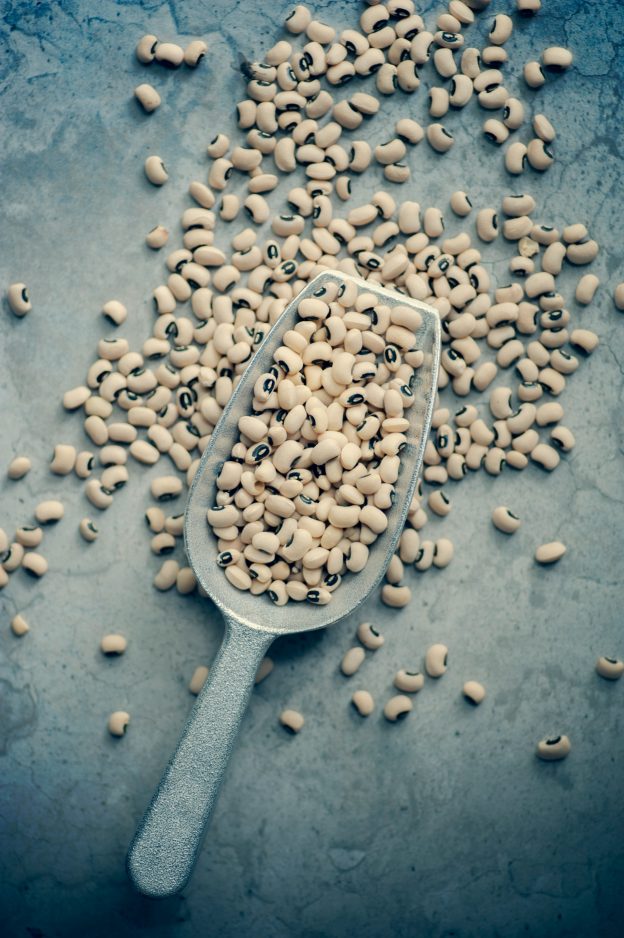
Black Eyed Peas
Submitted by: David J.
Recipe origin: Louisiana
I am the primary cook in our home. When my twin daughters graduated from high school, they asked me to write down my recipes so that they could cook them. I don’t cook from recipes, so it took me a while to quantify everything, but I wanted to do it for them.
Editor’s Note: Black eyed peas are traditionally served on New Year’s Day for good luck and prosperity on New Year’s Day.
1 pound dried black eyed peas
1 pound smoked ham, cubed
4 oz. tasso, diced (optional)
1/2 cup bacon grease or cooking oil
1 cup onions, chopped
1 cup celery, chopped
1 cup bell pepper, chopped
1/4 cup garlic, diced
1 tsp dried thyme
1 bay leaf
1 cup green onions, sliced
1/2 cup parsley, chopped
Beans cook much quicker if they are soaked overnight in cold water. This softens the outer shell and reduces the “bean effect.”
In a 4 quart stock pot, heat bacon grease over medium-high heat. Add onions, celery, bell pepper, garlic, thyme, ham, and tasso. Saute approximately 10-15 minutes, or until vegetables are wilted. Add bay leaf and black eyed peas. Add enough cold water to cover peas by 2 inches and bring to a low boil. Cook for 30 minutes, stirring occasionally. Reduce heat to simmer and continue cooking approximately 45 minutes more. Stir from time to time, as peas can settle to the bottom of the pot and stick. Once tender, mash about 1/3 of the peas on the side of the pot using a wooden spoon. Season to taste using salt and cracked black pepper. Add green onions and parsley and continue cooking until peas are tender and creamy.
Serve as a soup or over rice.
Ready to turn your recipes into something memorable? Click here to get started!
| Posted in:

Merry Meatless Mincemeat Pie
Submitted by: Amy
Recipe origin: England / Georgia
My dad, Bill, loved mincemeat pie, and he and my grandfather would sneak into the kitchen in the night to snack on it. I was afraid of it as a child–why is it called mincemeat? Could someone be trying to sneak gravy into my pie? The flavors are intense and perhaps a bit off-putting for children, and my grandfather’s comments about how it “put hair on your chest” probably weren’t helpful either. In olden days, mincemeat pie really contained minced meat (e.g. venison) along with all the fruit. My mother didn’t use meat, as I recall, but she did use beef suet. I don’t want to hunt for suet, so I go with butter instead. The filling can be prepared and refrigerated several days ahead–it’s a labor of love, so I highly recommend making ahead and finding victi–I mean volunteers–to help with all the chopping. You can simply serve the filling over ice cream, too, and skip the crust-making. May this pie be worth a midnight trip to your kitchen.
Dough for double pastry pie crust
1 ½ lb Granny Smith apples, peeled, cored, diced ¼-inch (about 3 large)
1 ½ lb Golden Delicious apples, peeled, cored, diced ¼-inch (about 3 large)
1 cup dried currants
1 cup golden raisins
¼ cup diced candied orange peel
2 tablespoons finely diced candied ginger
¾ cup packed dark brown sugar
Grated zest and juice from 1orange
Grated zest and juice from 1lemon
1 stick (4 oz) unsalted butter, cut into 8 pieces
1 teaspoon cinnamon
½ teaspoon ground ginger
½ teaspoon allspice
¼ teaspoon ground cloves
¼ teaspoon table salt
1 ½ cups apple cider, divided
1/3 cup Calvados or other brandy
1 tablespoon boiled cider (optional)
1 tablespoon milk, for crust
1 tablespoon sugar or sparkling sugar, for crust
Place all ingredients except brandy, ½ cup cider, milk, and sugar for crust in a large heavy saucepan on med heat. Bring to boil, then reduce heat to med-low and simmer gently, stirring occasionally, 3 hrs. Mixture will thicken and darken.
Stir in remaining ½ cup cider and brandy. Continue cooking, stirring often, 30 min or till liquid is syrupy and mixture is jammy. Cool to room temp.
Heat oven to 400 °F. Roll one piece of dough to a 12-in circle. Transfer to 9-in pie pan. Roll second dough piece to12-in circle. Spoon filling into pan. Place top dough over filling. Tuck edge of top dough under. Press to seal and create decorative crust. Cut 5 slits in top crust. Brush with milk and sprinkle with sugar. Bake till crust is light golden brown, 25 min. REDUCE OVEN TEMP to 350 °F. Bake till juices bubble and crust is deep golden brown, 35-45 min. Cool to room temp before serving.
Ready to turn your recipes into something memorable? Click here to get started!
| Posted in:

Aunt Francis’ Dinner Rolls
Submitted by: Regina
Recipe origin: USA
One particularly special recipe in our cookbook is Aunt Francis’ Dinner Rolls. Anyone who knew her and tasted her rolls was always amazed at how awesome they were. She made them for every holiday dinner.
2 tablespoons of Real Butter
2 tablespoons of Butter Crisco
3 tablespoons of White Sugar
1 Cup of hot water
1 packet of Fleischman’s Yeast
½ cup whole milk
1 beaten egg
1 teaspoon of salt
2 cups of flour
In a large bowl, mix the butter, sugar, and hot water. Add the milk and allow it to cool until lukewarm. Mix the yeast until dissolved in cup per directions on the packet. Once the yeast is dissolved, fold it into the mixture. Next, mix in the milk, egg, salt, and flour. Allow the dough to rise until doubled in size. For best results once the dough has doubled beat it down and let it rise again.
Grease 8 muffin cups. Divide the dough, roll it out and cut it with a juice glass (make sure that you flour the bottom of the glass before you cut the dough. Place the dough into the prepared muffin cups, and allow to rise again until doubled in size.
Preheat oven to 425 ℉.
Bake for 10 minutes or until golden brown in the preheated oven, or until a knife inserted in the center of a muffin comes out clean.
Ready to turn your recipes into something memorable? Click here to get started!
November 22, 2024 | Posted in:

Heritage Cookbook x Hively
Below, we’re very pleased to re-share an article from Hively, a trusted retirement navigator that empowers the 12,000 Americans retiring daily to make the most of their next chapter. The interview features Pam, a longtime Heritage Cookbook creator and Hively member who shared her cookbook-making journey with her retirement group!
Recipes to Memories, Writing a Family Cookbook with Pam
Meet Pam. A life-long Californian, Pam enjoys all things food related, traveling, reading, college football, and going to the theatre & jazz concerts. At the end of February, 2024, Pam retired from a 40+ year career in banking that she stumbled upon completely by accident.
For passionate home cook Pam, compiling a family cookbook was more than just assembling recipes – it was about preserving precious memories, traditions, and a legacy for future generations. Inspired by her son’s request to recreate his favorite childhood dishes, Pam’s project evolved into a rich anthology of family history and culinary delight.
Pam sees cooking as a magical act of bringing loved ones together. “You take bits and bobs of things, throw them into a pot, and voilà, you have something delicious that will warm your soul,” she shares. Her family cookbook beautifully blends recipes with cherished stories and photos, connecting the past, present, and future. One heartwarming tradition involves Pam’s granddaughter choosing a recipe from the book, like the family’s beloved key lime pie, to cook together.
In organizing her cookbook, Pam prioritized it being user-friendly for her family. She categorized recipes by type and included a clear index to help everyone easily find their favorites. Pam also made sure to capture the unique origins and traditions behind each dish, noting who inspired the recipe and any adaptations made over the years.
In creating her family cookbook, Pam chose Heritage Cookbook, a platform that offers customizable templates for crafting personalized cookbooks to create her family cookbook.Pam explored several options, but Heritage Cookbook stood out for its user-friendly templates that could handle both recipes and photos, while also allowing for plenty of customization. “I tried a few different platforms,” Pam shared, “but Heritage Cookbook was the one that gave me the creative freedom I needed.” Heritage Cookbook offered templates that accommodated her rich storytelling, making it easy to include family memories and anecdotes alongside the recipes.
The Hively team and community had the chance to ask Pam questions about her cookbook journey:
Q: How did you decide what order to put the recipes in?
I arranged them in standard cookbook categories – appetizers, main courses, desserts, and so on. I also included an index to make it easy to navigate, especially since some recipes connect to different branches of the family.
Q: What’s the oldest recipe in the cookbook?
One recipe dates back to my childhood— our family didn’t do traditional bread stuffing for Thanksgiving, but instead a rice dressing- Not sure where the recipe originated, but it is a family favorite that contains dried shiitake mushrooms and Chinese sausage (lop cheung). My niece eats it with turkey gravy to the exclusion of the rest of the meal. My cousins actually recently discovered the recipe in the cookbook and immediately made it!
There’s also a Swedish heirloom cookie recipe that my aunt only made at Christmas. That was the first recipe I ever collected, and it felt essential to include.
Q: Did you have family members taste-test the recipes?
Yes! I asked family members to review recipes and provide feedback. Some remembered adding a specific ingredient or adjusting the seasoning, which I noted. While I kept a consistent format, I left room for little variations, so my cousins helped make sure each recipe felt just right. For recipes like the key lime pie, I’d mention that the original version had a meringue topping, while my version includes coconut.
Q: What’s one of the biggest challenges you faced compiling recipes and stories?
Definitely prioritizing what to include. With a large family, I had to narrow down the list to recipes my son grew up with and truly loved. I also found the typing and proofreading tedious but essential to avoid errors.
Q: Did you include personal stories or memories along with the recipes?
Yes, each recipe often has a little note about who originally made it, how it’s been adapted, and even some funny family anecdotes. For example, for key lime pie, I note that it yields “eight servings – unless my son’s eating it, in which case it’s four.”
Q: How did you decide on the dedication for each book?
My first cookbook is dedicated to my son and granddaughter, as they’re the ones who inspired it. I also included a section of thanks to all the family members who contributed recipes or taste-tested for me. The second book, which is more about my personal journey with food, is dedicated to my husband. I even included a memoriam page to honor friends and family who have passed, and I added my dogs, who “taste-tested” everything too!
Q: How do you feel about the idea of leaving this cookbook as a legacy?
That’s really why I did it. Food is central to who I am, and I wanted my family to have something that connects them to me and to our traditions. It’s also a way to keep our food heritage alive and celebrate the stories and memories that go with each dish. Knowing that this book will be in my family for generations is so fulfilling.
Ready to turn your recipes into something memorable? Click here to get started!
November 13, 2024 | Posted in:

Summer Linguini with Tomatoes and Basil
Submitted by: Peggy
Recipe origin: USA
This recipe comes from the “Peggy’s Table” cookbook by Heritage Cookbook creator Peggy, who says this is “the BEST summer pasta recipe ever! I grow my own tomatoes and basil and my reward is this summer ritual every August!”
4 (or more) ripe large tomatoes, cut into ½-inch cubes
16 ounces Brie cheese, rind removed, torn into irregular pieces
1 cup fresh basil, in chiffonade
3 garlic cloves, peeled and finely minced
1 cup extra-virgin olive oil
2½ teaspoons salt
½ teaspoon freshly ground black pepper
1½ pounds linguini
Freshly grated Parmesan cheese
Combine tomatoes, Brie, basil, garlic, 1 cup olive oil, ½ teaspoon salt and the pepper in a large serving bowl. Prepare at least 2 hours before serving and set aside, covered, at room temperature.
Bring 6 quarts water to a boil in a large pot. Add 1 tablespoon olive oil and remaining salt. Add the linguini and boil under tender, but still firm, 8 to 10 minutes.
Drain pasta and immediately toss with the tomato sauce. Serve at once, passing the peppermill and grated Parmesan cheese. Serves 4 to 6.
[From the 1982 Silver Palette Cookbook]
Ready to turn your recipes into something memorable? Click here to get started!
| Posted in:
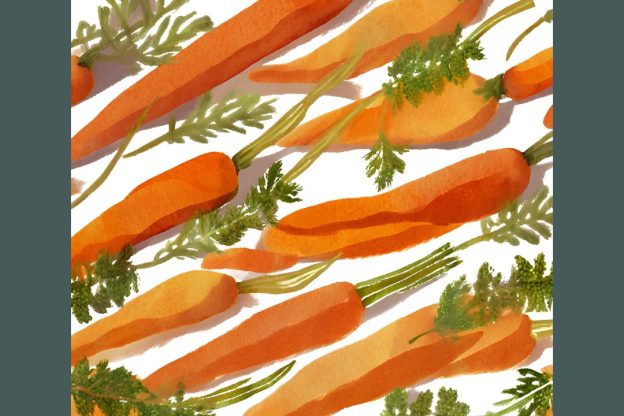
Roasted Carrots With Pine Nut Gremolata
Submitted by: Peggy
Recipe origin: USA
This recipe comes from the “Peggy’s Table” cookbook by Heritage Cookbook creator Peggy. Gremolata is a type of seasoning typically made of finely minced parsley, garlic, and lemon zest; in this case, orange rind is used instead.
1 tablespoon olive oil
¼ teaspoon kosher salt
¼ teaspoon pepper
1 pound trimmed small carrots
2 tablespoons chopped fresh parsley
2 tablespoons chopped fresh chives
1 tablespoon toasted pine nuts, chopped
2 teaspoons grated orange rind
1 teaspoon minced garlic
1 tablespoon sherry vinegar
Preheat oven to 450℃. Toss olive oil, salt and pepper with trimmed small carrots on a baking sheet. Bake at 450℃ for 20 minutes, stirring after 10 minutes. Reduce oven to 325℃ (keep pan in oven). Bake for 10 minutes more or until tender and beginning to brown.
Combine parsley, chives, chopped toasted pine nuts, grated orange rind and minced garlic. Add to carrots, add sherry vinegar and toss. Serves 2 to 4.
Ready to turn your recipes into something memorable? Click here to get started!
| Posted in:
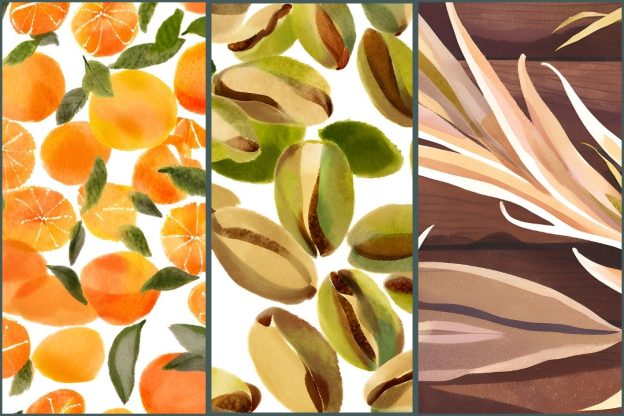
Orange Pistachio Wild Rice Salad
Submitted by: Peggy
Recipe origin: USA
This recipe comes from the “Peggy’s Table” cookbook by Heritage Cookbook creator Peggy.
2/3 cup wild rice
2/3 cup wild brown rice (Lundberg Farms) or brown rice
3 cups low-sodium chicken broth
3 tablespoons chopped unsalted pistachios
2 oranges
Zest from one orange
10 large fresh basil leaves, sliced into ribbons
¼ cup minced red onion
⅓ cup red wine vinegar
¼ cup olive oil
1 tablespoon fresh orange juice
1½ teaspoons Dijon mustard
1 teaspoon honey
¼ teaspoon salt
Combine the brown rice and wild rice and broth in a medium saucepan and bring to a boil. Cover, reduce heat to a slow simmer and cook until the water has evaporated and rice is fully cooked, 45 to 55 minutes. Remove from heat and cool completely.
Toast pistachios in a small dry skillet over medium-high heat until fragrant, about 3 minutes, stirring frequently; cool.
Grate the zest from one orange; set aside. Cut the top and bottom off of both oranges. Stand on end and remove the rest of the peel and white pith by cutting down the orange, following its curve with your knife. Cut between membrane and each segment; remove each segment. Repeat with the second orange. When the rice is cool, add the orange segments, the basil, onion, pistachios and orange zest and mix to incorporate.
To make the dressing, whisk together the vinegar, orange juice (from first zested orange), oil, mustard, honey and salt in a small bowl. Pour over the rice mixture and mix. (May not need all the dressing). The salad will keep in the refrigerator in an airtight container for a day or two. Serves 6.
Ready to turn your recipes into something memorable? Click here to get started!
| Posted in:
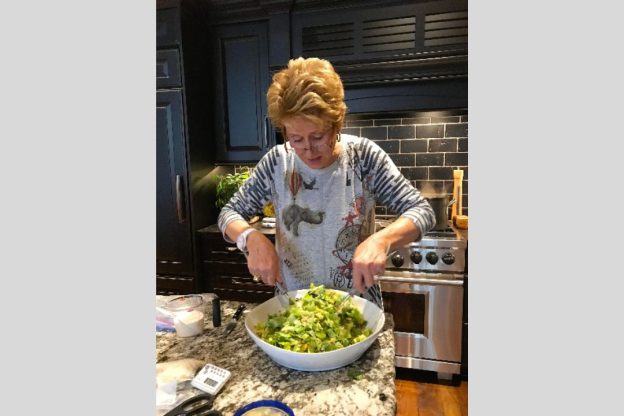
Avocado and Butter Lettuce Salad
Submitted by: Peggy
Recipe origin: USA
This recipe comes from the “Peggy’s Table” cookbook by Heritage Cookbook creator Peggy.
Butter lettuce
Avocados (½ – 1 per person)
Fresh chives, cut in about ¼-inch pieces
Lemon Vinaigrette
1 lemon, juiced
3 tablespoons red wine vinegar
6 tablespoons olive oil
1 shallot, finely minced
2 cloves, garlic, finely minced
Kosher salt and pepper
Carefully trim the butter lettuce leaves off the head; leaves left whole. Rinse well and dry.
Combine dressing ingredients and mix well.
Toss butter lettuce leaves with dressing; place on large platter. Separately toss the avocado slices with dressing, then arrange on top of butter lettuce and sprinkle with chopped fresh chives.
OR
Toss lettuce with lemon vinaigrette. Arrange leaves on individual salad plates, starting with largest on the bottom. Slice or scoop avocados in pieces and toss with dressing; place a serving of avocado slices on center of butter lettuce leaves. Sprinkle with chopped fresh chives.
Ready to turn your recipes into something memorable? Click here to get started!
